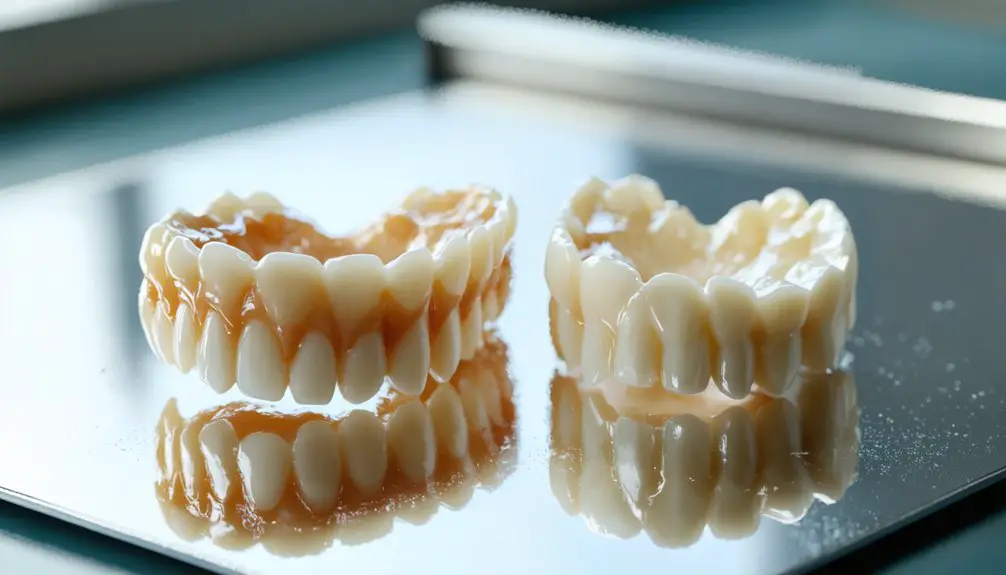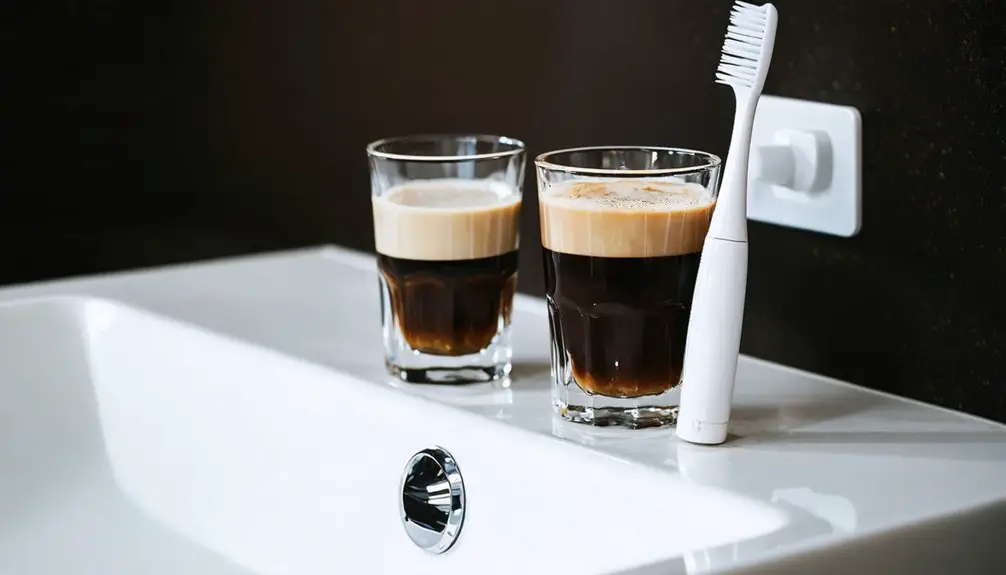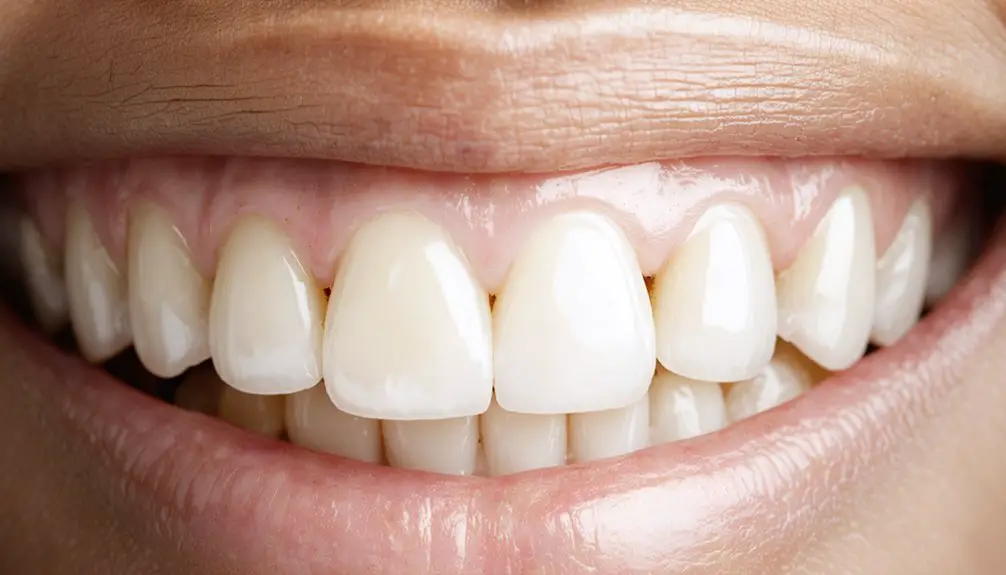You’ll find several proven solutions for removing tough teeth stains. Professional ultrasonic cleaning uses sound waves for gentle yet effective removal, while advanced air-flow polishing combines compressed air and specialized powders to reach deep stains. In-office laser whitening procedures can transform your smile in just one hour, and microabrasion techniques achieve a 97% improvement rate. For permanent stains, custom-fitted trays and restorative options offer lasting solutions. Understanding your specific stain type will guide you to the most effective treatment approach.
Key Takeaways
- Professional ultrasonic cleaning provides gentle yet effective stain removal, reaching deep into periodontal pockets while protecting sensitive teeth and gums.
- Air-Flow Polishing removes stains three times faster than conventional methods, using specialized powders to reach up to 10mm deep.
- In-office laser and LED whitening treatments with high-concentration peroxide deliver noticeable results in just one hour.
- Custom-fitted whitening trays ensure optimal gel contact and even distribution, providing superior results when used consistently for 2-4 weeks.
- Microabrasion combined with bleaching achieves a 97% improvement rate for tough intrinsic stains while preserving natural enamel structure.
Understanding Different Types of Tooth Stains
Tooth stains fall into two primary categories: extrinsic and intrinsic discoloration.
Extrinsic stains appear on the tooth’s surface, typically caused by external factors like coffee, tea, red wine, and tobacco use. You’ll find these stains range in color from green to black, depending on their source, and they’re generally responsive to surface cleaning and polishing. Poor dental hygiene can make these surface stains more severe and harder to remove. Black stains can occur due to iron in saliva.
Intrinsic stains, however, develop within the tooth structure itself. These deeper discolorations often result from fluoride exposure, tooth trauma, or certain medications like tetracycline. You won’t be able to address these effectively with over-the-counter products alone.
As you age, you might experience a combination of both types, as natural enamel wear reveals more of the yellowish dentin beneath, while accumulated exposure to staining substances compounds the issue.
Professional Cleaning and Ultrasonic Treatment
When seeking professional dental cleaning, you’ll encounter advanced ultrasonic treatment methods that revolutionize the removal of stubborn stains and deposits.
Using high-frequency sound waves between 20,000 and 45,000 cycles per second, ultrasonic cleaning offers significant benefits over traditional manual scaling.
Ultrasonic dental cleaning harnesses powerful sound waves to deliver superior results beyond what traditional hand scaling methods can achieve.
The ultrasonic benefits include gentler treatment for sensitive teeth and gums, while achieving superior cleaning efficiency in hard-to-reach areas.
Regular treatments help maintain optimal oral health and prevent the need for more invasive procedures down the line.
You’ll experience less discomfort as the technology requires minimal pressure and includes a cooling water spray that flushes away debris.
The procedure is particularly effective for cleaning subgingival areas and periodontal pockets, making it ideal for treating and preventing gum disease.
This modern approach delivers fast and efficient results compared to manual cleaning methods, especially when dealing with heavy tartar buildup.
It’s also safe for most dental work, including implants, crowns, and bridges, though patients with pacemakers may need alternative treatments.
Advanced Air-Flow Polishing Technology
Modern air-flow polishing technology represents a significant advancement in dental stain removal, combining compressed air, water, and specialized powder particles to create a precise cleaning jet.
You’ll find that air flow benefits include superior stain removal without the discomfort of traditional scaling tools. The system uses gentle powders like erythritol, sodium bicarbonate, or glycine, delivering exceptional results without roughening tooth surfaces. The technology reaches up to 10mm into periodontal pockets for comprehensive cleaning.
This technology effectively removes stubborn stains from coffee, tea, wine, and tobacco while protecting your dental work. The process is three times faster at removing stains compared to conventional cleaning methods.
The procedure is painless and quick, typically lasting 30-60 minutes. The heated water stream guarantees your comfort while the non-contact process eliminates the vibration and pressure associated with conventional cleaning methods.
For challenging stains and sensitive teeth, air-flow polishing offers a sophisticated solution that’s both gentle and thorough.
In-Office Whitening Procedures
Professional in-office whitening harnesses powerful laser and LED light technologies to break down stubborn stains through precisely controlled bleaching agents.
The latest laser advancements ensure minimal tissue impact while providing enhanced precision during the procedure.
You’ll experience rapid results as these advanced systems activate high-concentration peroxide formulations, achieving significant whitening in a single visit. In fact, you can expect to see noticeable changes after just one hour of treatment.
While you might notice temporary tooth sensitivity, your dental professional will customize the treatment intensity and duration to maximize effectiveness while managing any discomfort.
Powerful Light-Based Treatments
Light-based teeth whitening represents a major advancement in professional stain removal technology. When you choose this treatment, your dental professional will apply specialized whitening gels containing hydrogen peroxide or carbamide peroxide to your teeth.
Advanced blue LED light activation then triggers an accelerated oxidation process, breaking down even stubborn stains more effectively than gel treatments alone. Your dentist will take a shade measurement first to track your whitening progress. The latest machines feature user-friendly controls that allow dental staff to easily adjust and monitor treatments.
You’ll find several light technologies available, with blue LED being the safest and most widely used option. These treatments can lighten your teeth by up to 10 shades in just 30 minutes, making them considerably more efficient than at-home alternatives.
Modern systems also incorporate adjustable intensity settings to minimize sensitivity while maintaining powerful whitening action. For best results, you may need periodic maintenance sessions to control new stain formation.
Custom Tray Application Methods
Custom-fitted whitening trays represent a highly effective approach to professional teeth whitening that builds upon traditional light-based treatments. Your dental provider will create trays that precisely match your unique dental anatomy, ensuring ideal gel contact and minimal leakage.
Custom tray benefits include even distribution of professional-grade whitening gel and superior results compared to over-the-counter alternatives.
- Place a small amount of gel in each tooth impression to prevent overflow
- Dry your teeth thoroughly before inserting trays for maximum effectiveness
- Wear trays according to your dentist’s prescribed duration (30 minutes to overnight)
- Clean trays after each use to maintain hygiene and effectiveness
- Follow the 2-4 week treatment protocol consistently for ideal results
Effective gel application through custom trays delivers uniform whitening while protecting your gums from irritation, making it a reliable choice for achieving lasting brightness.
Immediate Results Vs Sensitivity
While in-office whitening procedures deliver dramatic results in a single session, they often present a trade-off between immediate brightness and temporary tooth sensitivity.
You’ll notice up to eight shades of improvement within 90 minutes using systems like Zoom whitening, though you may experience short-term discomfort.
Modern sensitivity management techniques have greatly enhanced the comfort level of these treatments. Your dentist will use specialized desensitizing agents containing potassium nitrate and fluoride to minimize post-treatment sensitivity.
Despite the higher cost of around $650, you’ll benefit from professional oversight and faster results compared to at-home options.
Though the effects aren’t permanent, you can maintain your brighter smile through periodic touch-ups, with your dentist carefully monitoring the timing to guarantee safe, effective outcomes.
Microabrasion and Specialized Techniques
Among advanced dental stain removal techniques, microabrasion stands out as a precise method that combines mild abrasive and acidic solutions to eliminate stubborn surface stains.
You’ll find microabrasion benefits include exceptional improvement in over 97% of cases, particularly for intrinsic stains and fluorosis. After treatment, your dentist will apply remineralizing agents to strengthen the enamel and enhance its natural luster.
- Removes white, yellow, and brown stains that bleaching can’t address
- Preserves natural enamel structure through minimal invasion
- Provides immediate visible results in a single session
- Works effectively for patients sensitive to whitening chemicals
- Can be combined with bleaching for enhanced results
This specialized technique requires proper isolation and professional application, ensuring both safety and ideal outcomes while maintaining your enamel’s integrity.
Restorative Solutions for Permanent Stains

For teeth with permanent stains that resist conventional whitening methods, restorative solutions offer transformative results through various clinical interventions.
Your dentist can recommend several restorative options based on your specific stain treatment needs.
Modern dentistry offers tailored restorative solutions for every type of tooth staining, ensuring personalized treatment for optimal results.
Dental veneers provide an excellent solution for intrinsic stains, creating a new surface that masks deep discoloration.
For severely affected teeth, full crowns offer extensive coverage while restoring both function and aesthetics.
If you’re seeking a less invasive approach, composite bonding can effectively address localized stains with minimal tooth preparation.
You’ll find that each option serves different purposes: veneers last 10-15 years with proper care, crowns provide full structural support, and bonding offers a cost-effective solution for moderate staining.
Your dental professional will help determine which restorative treatment best suits your specific situation.
Daily Habits for Long-Term Stain Prevention
You’ll protect your teeth from stains by choosing crunchy fruits and vegetables that naturally scrub teeth surfaces while stimulating saliva production.
When consuming beverages known to stain teeth, such as coffee, tea, or red wine, use a straw to minimize contact with your front teeth and rinse with water immediately afterward.
Your consistent attention to beverage choices and snacking habits will greatly reduce long-term tooth discoloration.
Smart Snacking Choices Matter
Making strategic snacking choices plays a vital role in protecting your teeth from stubborn stains and discoloration. By incorporating nutrient benefits through smart dietary strategies, you’ll strengthen your enamel’s natural defense against staining while maintaining ideal oral health.
The key lies in selecting foods that combine mechanical cleaning action with protective nutrients, particularly those that stimulate saliva production and neutralize harmful acids.
- Choose nuts for their protein content and natural scrubbing action
- Pair staining beverages with dairy products, especially milk or cheese
- Opt for crunchy fruits and vegetables that increase saliva production
- Control portions of stain-causing foods and limit exposure time
- Include iron-rich green leafy vegetables to create an acid-resistant barrier
Mindful Beverage Consumption Habits
While enjoying your favorite beverages remains an important part of daily life, adopting mindful consumption habits can dramatically reduce tooth staining over time.
Implement straw usage when drinking dark or acidic beverages like coffee, red wine, and cola to minimize contact with your teeth. Position the straw toward the back of your tongue to bypass enamel exposure altogether.
Master effective rinsing techniques by swishing water immediately after consuming staining drinks. This practice dilutes acids and washes away pigments before they can bind to your enamel.
You’ll achieve better results by choosing lighter roasts of coffee, adding milk to black tea, and maintaining proper hydration throughout the day.
Remember to wait 30 minutes after acidic beverages before brushing to protect your enamel’s integrity.
Frequently Asked Questions
Can I Eat or Drink Immediately After Professional Teeth Whitening Treatment?
Want your whitening results to last? You shouldn’t eat or drink for at least 30 minutes post-treatment. Follow aftercare guidelines by sticking to clear liquids and waiting 48 hours for whitening maintenance.
How Long Should I Wait Between Different Types of Stain Removal Treatments?
You’ll need 6-12 months between professional treatments, 2-4 weeks for at-home kits, and 1-2 weeks for natural methods. Maintain treatment effectiveness by following product-specific intervals to protect enamel.
Will Dental Stain Removal Affect Existing Crowns or Fillings?
Professional stain removal won’t whiten your crowns or fillings since they’re made of non-porous materials. You’ll need to discuss crown sensitivity and possible filling discoloration with your dentist before treatment.
Are There Any Medications That Can Interfere With Teeth Whitening Results?
Yes, certain antibiotics like tetracycline and medications causing dry mouth can limit whitening ingredients’ effectiveness. You’ll need to inform your dentist about medication effects for proper treatment planning.
Does Smoking After Stain Removal Treatment Cancel Out the Effects Completely?
Ever notice how quickly tar builds up? While smoking doesn’t instantly nullify stain removal, it drastically reduces stain longevity, causing discoloration to return within weeks rather than the months you’d normally expect.
References
- https://smyledentist.com/blog/professional-teeth-stain-removal-guide/
- https://clinicadentalmedident.com/en/most-common-types-of-dental-stains-and-how-to-remove-them/
- https://www.nature.com/articles/bdjteam2017175
- https://sculptdentalspa.com/teeth-stain-removal-charleston/
- https://mypenndentist.org/dental-tips/2024/02/13/how-to-remove-stains-from-teeth/
- https://www.alliedacademies.org/articles/classification-of-tooth-staining.pdf
- https://markhamdentalsmiles.com/types-of-teeth-stains-how-to-remove-them/
- https://www.dentalcare.com/en-us/ce-courses/ce491/staining-types-and-causes
- https://www.martinezdentistryindy.com/blog/types-of-tooth-stains-and-how-to-get-rid-of-them/
- https://www.smartdentalcare.net/2022/01/12/analyzing-teeth-discoloration-types-and-causes-of-staining/



